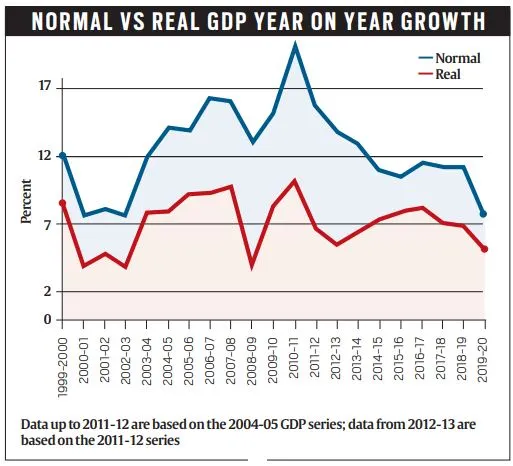Note4Students
From UPSC perspective, the following things are important :
Prelims level: GDP, GNP, GVA etc.
Mains level: First Advance Estimates

The First Advance Estimates (FAE) were recently released by the Ministry of Statistics and Programme Implementation (MoSPI).
The First Advance Estimates and their significance
- The First Advance Estimates (FAE) extrapolate a variety of data, such as the Index of Industrial Production (IIP), the financial performance of listed companies, first advance estimates of crop production etc., for the first 7 to 8 months to arrive at the annual figure.
- The significance of the FAE is that this is the final bit of official data before the government presents its next Budget.
- The sector-wise Estimates are obtained by extrapolation of indicators like-
- IIP of first 7 months of the financial year,
- financial performance of Listed Companies in the Private Corporate sector available upto quarter ending September, 2019
- 1st Advance Estimates of Crop production,
- accounts of Central & State Governments, information on indicators like Deposits & Credits, Passenger and Freight earnings of Railways, Passengers and Cargo handled by Civil Aviation, Cargo etc., available for first 8 months of the financial year”.
Estimates for 2018-19
- It estimated India’s GDP will grow by just 5 per cent in the current financial year (2019-20). Last financial year, 2018-19, the Indian economy grew at 6.8 per cent.
- The gross value added (GVA), which maps the economic activity from the income side as against the GDP which maps it from the expenditure side, is expected to grow by 4.9 per cent in 2019-20 as against 6.6 per cent in 2018-19.
Drivers of the GDP
There are four main drivers of the GDP:
- One, the private consumption expenditure – that is the expenditure that you and I make in our personal capacity. This category has grown by just 5.7 per cent in 2019-20 while it grew by 8 per cent last financial year.
- The second driver is the expenditure made by the Government. This grew by 10.5 per cent, which is higher than the rate of growth (9.2 per cent) in the last financial year.
- But the most disappointing number is the deceleration in business investments in the economy.
- This driver, which is the key to sustainable long-term growth, grew by less than 1 per cent; last financial year it grew by 10 per cent.
- This shows that while the private consumption demand is tepid, businesses have completely turned off the tap on new investments despite the government making a once-in-generation cut in corporate taxes.
Performance in terms of GVA
- The GVA data provides a detailed picture. Given that the overall GVA has decelerated sharply, almost all sectors have witnessed slower growth in economic activity.
- Only “Public Administration, Defence and Other Services,“ which essentially measures how the government did, grew by 9.1 per cent.
- All other sectors saw a GVA growth that was slower than the average growth in the last financial year.
- The worst performing sectors are ‘Agriculture, Forestry and Fishing’, ‘Mining and Quarrying’, ‘Manufacturing’ and ‘Construction’, which are expected to see a GVA growth of 2.8 per cent, 1.5 per cent, 2.0 per cent and 3.2 per cent respectively.
Back2Basics
Real vs. Nominal GDP
- GDP is the total market value of all goods and services produced in the economy during a particular year, inclusive of all taxes and subsidies on products.
- The market value taken at current prices is the nominal GDP.
- The value taken at constant prices — that is prices for all products taken at an unchanged base year (2011) — is the real GDP.
- In simple terms, real GDP is nominal GDP stripped of inflation.
- Real GDP growth thus measures how much the production of goods and services in the economy has increased in actual physical terms during a year.
- Nominal GDP growth, on the other hand, is a measure of the increase in incomes resulting from rise in both production and prices.
Get an IAS/IPS ranker as your 1: 1 personal mentor for UPSC 2024
